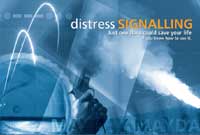

Do you know what mandatory
distress signals are required for your boat? Do you know how to use them?
Can you signal a distress situation in all conditions (day and night)?
The Distress Signaling seminar will train your family on the use of
flares as well as alternate non-pyrotechnic signals.
Don’t wait until an emergency occurs. Be trained in Distress Signaling
today!
Type A: Aerial parachute flares
Correct use of parachute flares
Type B: Multi-star red aerial flares
Correct use of hand-held multi-star flares
Correct use of 12 gauge flare launchers
Pen launchers
Type C: Hand-held flares
Correct use of hand-held flares
Type D: Smoke flares
Correct use of water immersion smoke flares
Correct use of hand-held smoke flares
SOLAS approved flares
Flares used for illumination
Type A: Aerial illuminating white parachute flares
Correct use of white parachute flares
Type C: Hand-held white illuminating flares
Correct use of white hand-held flares
Principles of signaling
When to signal with flares
When to use aerial flares
When to use hand-held flares
Rules of signaling
Regulations governing the use of distress flares
Approval numbers
Date of manufacture
Suggested distress signals to be carried on board
Purchase of flares
Storage of flares
Disposal of flares
Other distress signals
Daytime signals
Night-time signals
Mandatory Canadian flare requirements
Fines for contravention of the Canada Shipping Act
Mandatory US flare requirements
Assisting a vessel in distress
Copyright ©1998,2005
Canadian Power & Sail Squadrons®
Escadrilles canadiennes de plaisance